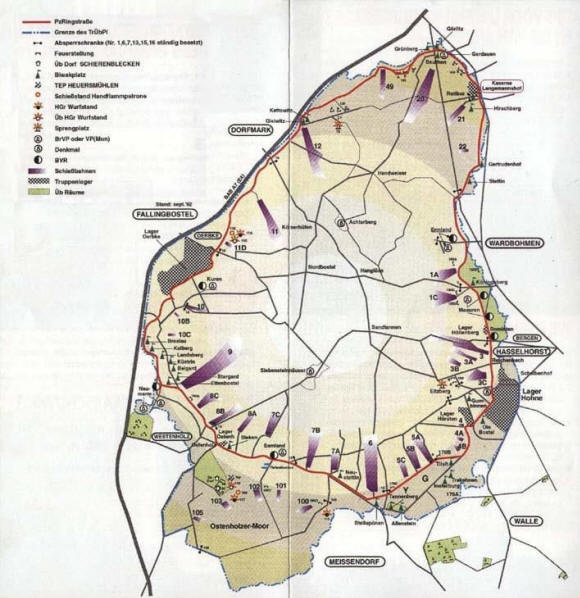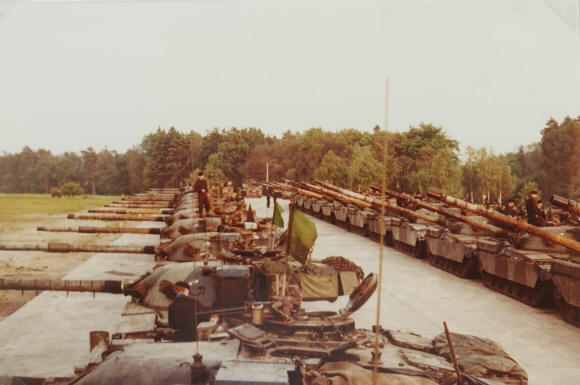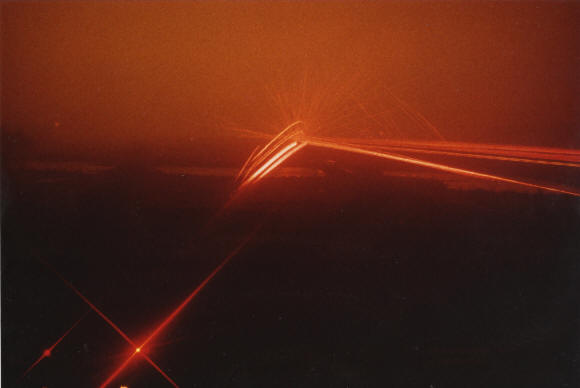|

AND SO TO
RANGES, or firing camp as some other regiments called
it. This happened once every year or two years depending
on which particular training cycle you found your self
on. We took it very seriously, as all good regiments
did, because unlike manoeuvre training where your
performance could rest on the opinion of the senior
officer present, on the ranges your performance was
easily measurable by the number of holes you put in the
target and the time it took you to do it. So were on our
mettle and, for those horrified by the bacchanalian
excesses recounted in the last episode, there was nigh
on no alcohol either, during working hours at least.
Training started in camp on various training aids which
simulated the real thing. My first year I hadn’t
completed my troop leader’s course before I joined the
Regiment and so, quite rightly, wasn’t entrusted to
command a tank at ranges. However it was thought a good
idea that I should be the squadron 2ic’s loader during
firing, which was good experience before going off to
Lulworth in Dorset where gunnery training takes place.
Initial loaders’ training took place in a “SIM”, a sort
of open plan, tank turret mock-up with a pretty faithful
working reproduction of the gun breech crew stations,
and ammunition stowage.
Of course the practice ammunition was inert, which is
just as well because in my very first attempt at the
loader’s drill I dropped the round – I hadn’t expected
it to be so heavy! As the only officer in my class of
about eight there was much smirking and tittering from
the rest, but it was much warranted. I didn’t drop one
again. Meanwhile the commanders and gunners went through
their own simulator the name of which I have forgotten
but ended up with airgun pellets being fired at rubber
tank targets in a sand box on a miniature range.
Sophisticated it wasn’t, and I guess it must have been
of Second World War vintage at least.

Anyway,
after a few weeks’ build up we would then embark en
masse for Hohne Ranges (above) just up the road, tanks
and drivers by rail or transporter and rest by road.
Nowadays I understand that, under some scheme called
Whole Fleet Management (WFM), you only have a few tanks
for training in barracks and the rest you sign out like
hire cars for field training and ranges. None of that
back in the day, we owned our own tanks and took them
with us (Canada excepted) for training.
The loading up of our tanks in barracks if we were going
by road brought a little bit of post war history with
it. One of the tank transporter regiments was formed by
the “Mojos”, members of the British Army of the Rhine’s
(BAOR) Mixed Service Organisation (MSO) comprising
former PoWs and Displaced Persons who either couldn’t or
wouldn’t return home at the end of the War. Many of them
were Poles who did not wish to return to their home
country whilst it was under communist rule.
Anyway, when it was time to load up the Mojos would roar
into barracks in their huge tank transporters and do the
circuit, and as each one passed a tank would fall in
behind and follow it round until they were all in. The
tanks would then load with much roaring on engines, and
then head out straight away, or perhaps camp for the
night on the barrack square before making the journey.
Our tank drivers went with them in their cabs. The Mojos
had their own rank structure and customs and were expert
at their job, not surprising perhaps as some had been
doing it for well nigh 40 years by then. They were also
fiends for their schnapps and slivovitz at any time of
the day or night and Herculean smokers. As for their
food, well, best not ask!
Eventually, after the odd hiccup here and there,
personnel and tanks would meet up at Hohne. The tanks
would be parked up and guarded on the firing point(s)
and the rest of us would pile into our accommodation in
the camp proper. To be honest I can’t remember much
about our living arrangements except it was typically
Teutonic, hardly surprising as our predecessors had been
at one point the Wehrmacht and Waffen SS tank battalions
of Nazi Germany.

Hot Range Firing
It was a
matter of pride to get the first round down range as
soon as clearance was given to fire at 8am in the
morning, weather and range fires permitting. So we got
up at some unearthly hour in the morning (my memory says
4am but that can’t be right, surely?), had breakfast and
were transported out to whatever range we were on in the
open backed Stalwart trucks of MT Troop. Fine, if a bit
nippy, if the weather was OK, not so fine if it was
raining.
On arriving at the firing point there was a flurry of
activity until all was ready. Then we would wait. You
always wait in the army. Sandhurst’s motto “Serve To
Lead” was always amended to “Rush To Wait” at that
gilded institution, and that set the tone for most of my
military career. The RAF transport bods – Crab Air –
were past masters at having their passengers, or “pax”
in Brylcreem Boy-speak, turn up at some unearthly hour
to get their flights, and then making them wait until
pilots and crews had a leisurely breakfast, said goodbye
to their boyfriends and girlfriends, checked out of the
hotels where they had to stay otherwise they’d be “too
tired to fly”, and amble over to the airport. How we
hate(d) them for their lax, matey, lack of discipline
and regard for their temporary charges.
But I digress. The programme tended to be much the same,
for obvious reasons not least of which was new recruits
coming in all the time. First individual tank static
firing, to get the technicalities right and settle the
younger boys down. Then troop firing, when troop leaders
had to control their troops as multiple targets were
popped at the same time. “Alpha this is 41. Yours on the
right, 1500 metres.” “Ah canny – it’s oot o’ arc tae
me!” “Roger, mine then. George, sabot tank on.” “ON!
1350!” “1350 FIRE”. “Firing NOW!” (Bang) “TARGET!”
“Target, stop.” “This is 41B – two targets left, 1300
metres.” “41, got them. Alpha and Bravo split.” And so
it went. Exciting stuff, combined with the “whoomph” of
the 120mm gun and the smell of cordite, the yelling of
the crew over the intercom, and the constant crackling
of the radio from control and the other tanks.

Night Firing at Hohne
Then we
progressed on to battle runs, where we advanced as troop
down the range towards the targets by bounds and the
gunnery staff popped targets as we went. For this we
were closed down and keeping the troop in line (for
safety purposes) and allocating targets was difficult
via narrow vision blocks whilst searching for new
targets at the same time. The gun was stabilised in
azimuth and elevation so we could shoot pretty
accurately on the move, but it made the loader’s task
all the more dangerous as the breech swung up and down
as we bounced down the range. If the staff popped some
men-sized targets we then had to shift to engaging with
the co-axial machine gun, and the turret would fill with
cordite fumes. If you weren’t careful they could
temporarily asphyxiate your loader and you’d look round
to find him unconscious on the turret floor.
Dangers aside, however, it was great fun and we were
quite good at it. There were always amusing incidents.
Every so often someone would get a hangfire, when
instead of a bang as the round went off there would be a
fizzing sound, often accompanied by smoke coming out of
the breech, as the charge decided whether to go off or
not. Usually they went off after a few seconds, but
occasionally they didn’t go off at all, and then you
were into the whole misfire drill followed by a wait of
30 minutes before you could open the breech. This latter
event was always approached with a certain amount of
trepidation as there was always a chance that the inrush
of air would set off the charge and it would blow back
into the turret and roast everybody in it. Thankfully it
never happened in my time, although I did witness a crew
so frightened by the hiss and smoke of a hangfire that
they all bailed out and stood on the back deck of their
tank, whereupon the gun fired and the round went off
downrange. It was the only time I saw an unmanned tank
fire.
To come in Part 10; Canada.
© Stuart Crawford 2020 |
